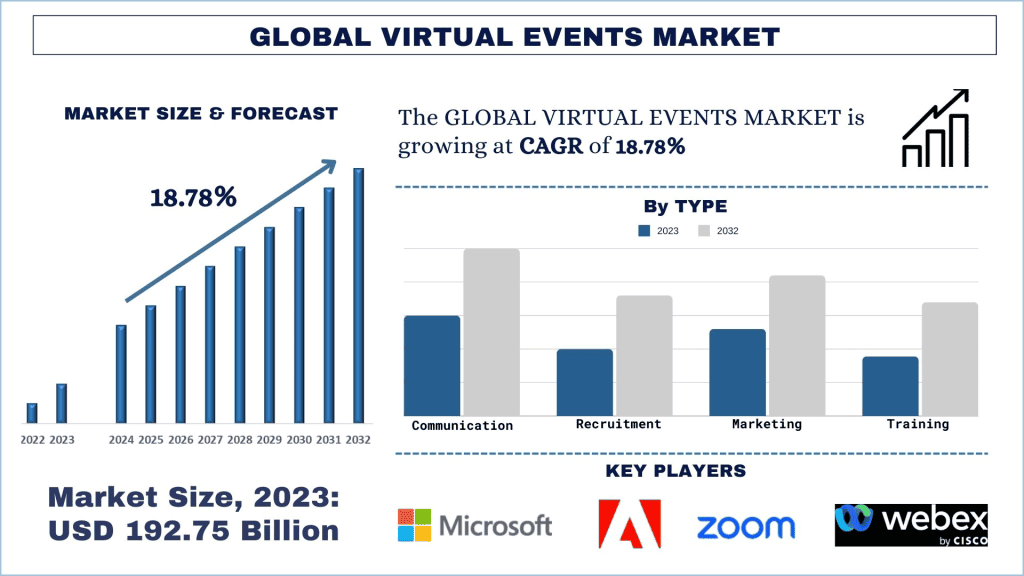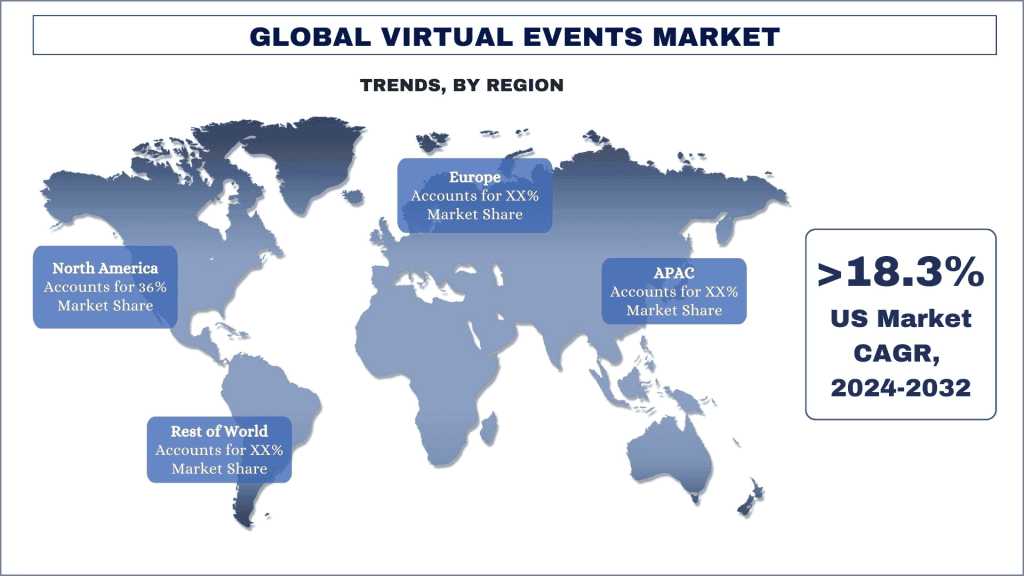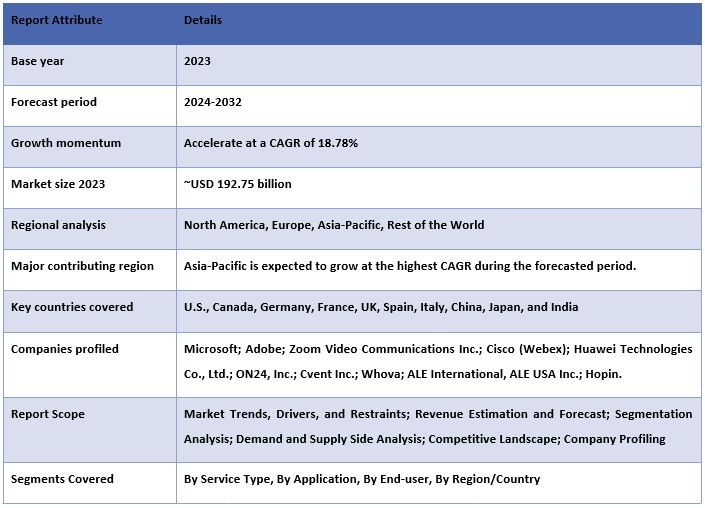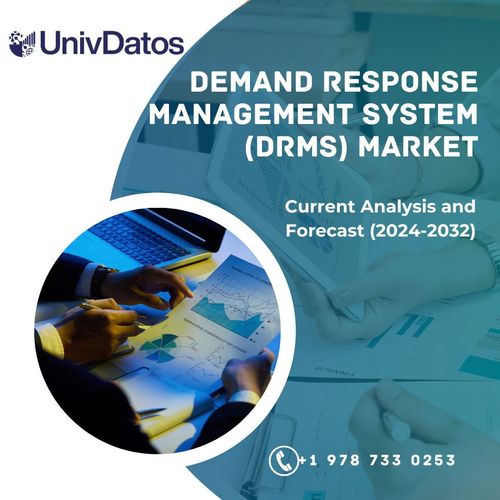- Home
- About Us
- Industry
- Services
- Reading
- Contact Us
Virtual Events Market: Current Analysis and Forecast (2024-2032)
Emphasis on Service Type (Communication, Recruitment, Marketing, Training); Application (Conferences, Exhibitions/Trade Shows, Summits, Others); End-user (Educational Institution, Corporate, Government, Others); and Region/Country

The Virtual Events Market was valued at approximately USD 192.75 Billion in 2023 and is expected to grow at a substantial CAGR of around 18.78% during the forecast period (2024-2032) owing to the high demand for work-life balance by employees.
Virtual Events Market Analysis
Virtual events are online gatherings that utilize digital platforms to connect attendees from various locations. These events allow for live or recorded interactions through webinars, virtual conferences, workshops, and networking sessions. These events leverage video conferencing, live streaming, virtual reality (VR), and augmented reality (AR) to create interactive and engaging experiences similar to physical events. Virtual events range from small-scale meetings to large-scale conferences and trade shows, offering flexibility and scalability to accommodate diverse audience sizes and needs.
The shift towards virtual events supports corporate sustainability initiatives by reducing carbon footprints associated with business travel and physical events.
As per the data of IEEE.org, 2024:
A one-day virtual event with 200 attendees results in carbon emissions equivalent to driving 3,300 miles or burning 1,500 pounds of coal! That same event would generate nearly 66 TIMES more carbon emissions if held face-to-face.
Over 60% of carbon emissions from virtual conferences are associated with network data transfers from uploading and downloading data such as video calls, streaming, presentations, etc.
Virtual Events Market Trends
This section discusses the key market trends influencing the various segments of the virtual events market as identified by our research experts.
Educational Institutions Virtual Events Transforming Industry
Educational institutions are expected to grow with a significant CAGR in the forecast period (2024-2032). The shift to online learning environments brought about by the pandemic has underscored the need to utilize virtual platforms to offer lectures, seminars, and workshops. Furthermore, virtual events have enabled opportunities for international partnerships, guest speakers, and virtual campus visits, which have great potential for students and teachers. According to the National Center for Education Statistics (NCES), 2024 stats reveal that over 10 million college students enrolled in at least one distance education class in the fall of 2022. Slightly less than half of those students took all of their courses online. Most of these online learners are undergraduates (8.4 million) attending four-year public institutions (7.4 million).

North America leads the market in 2023
North America is a significant driver of the virtual events market, propelled by its advanced technological infrastructure and high adoption rates of digital solutions. Adding to this, North America’s leading technology companies that develop and innovate virtual event platforms contribute to the market’s rapid growth and sophistication. The widespread availability of high-speed internet and the tech-savvy nature of the workforce facilitate seamless execution and participation in virtual events. As per the World Bank, in 2021, around 92% of North America’s population uses the internet. According to the Federal Communications Commission benchmarks, more than 97% of American’s people had access to high-speed internet in 2021. North America’s proactive approach to integrating advanced technologies such as artificial intelligence (AI), augmented reality (AR), and virtual reality (VR) into virtual events also boosts market growth by providing immersive and interactive experiences for attendees.

Virtual Events Industry Overview
The Virtual Events market is competitive, with several global and international market players. The key players are adopting different growth strategies to enhance their market presence, such as partnerships, agreements, collaborations, new product launches, geographical expansions, and mergers and acquisitions. Some of the major players operating in the market are Microsoft; Adobe; Zoom Video Communications Inc.; Cisco (Webex); Huawei Technologies Co., Ltd.; ON24, Inc.; Cvent Inc.; Whova; ALE International, ALE USA Inc.; Hopin.
Virtual Events Market News
On June 20, 2024, Zoom launched Workvivo by Zoom for its reseller partners. Workvivo, the employee experience platform designed to simplify communication and drive engagement, will now be available for all Zoom’s channel partners to sell to customers. Also, Zoom acquired Workvivo in April 2023 to extend Zoom’s collaboration platform and offer its customers new ways to keep employees informed, engaged, and connected.
On April 4, 2024, Cloud Software Group Inc. and Microsoft Corp. announced they are deepening their collaboration through an eight-year strategic partnership agreement. The agreement will strengthen the go-to-market collaboration for the Citrix® virtual application and desktop platform and support the development of new cloud and AI solutions with an integrated product roadmap. Additionally, Cloud Software Group will make a USD 1.65 billion commitment to the Microsoft cloud and its generative AI capabilities.
On September 15, 2022, Adobe announced it had entered into a definitive merger agreement to acquire Figma, a leading web-first collaborative design platform, for approximately USD 20 billion in cash and stock. The combination of Adobe and Figma will usher in a new era of collaborative creativity.
Virtual Events Market Report Coverage

Reasons to buy this report:
- The study includes market sizing and forecasting analysis validated by authenticated key industry experts.
- The report presents a quick review of overall industry performance at one glance.
- The report covers an in-depth analysis of prominent industry peers with a primary focus on key business financials, product portfolios, expansion strategies, and recent developments.
- Detailed examination of drivers, restraints, key trends, and opportunities prevailing in the industry.
- The study comprehensively covers the market across different segments.
- Deep dive regional level analysis of the industry.
Customization Options:
The global Virtual Events market can be customized further as per the requirement or any other market segment. Besides this, UMI understands that you may have your own business needs, hence feel free to connect with us to get a report that completely suits your requirements.
Table of Content
Research Methodology for the Virtual Events Market Analysis (2022-2032)
Analyzing the historical market, estimating the current market, and forecasting the future market of the global Virtual Events market were the three major steps undertaken to create and analyze the adoption of Virtual Events in major regions globally. Exhaustive secondary research was conducted to collect the historical market numbers and estimate the current market size. Secondly, to validate these insights, numerous findings and assumptions were taken into consideration. Moreover, exhaustive primary interviews were also conducted, with industry experts across the value chain of the global Virtual Events market. Post assumption and validation of market numbers through primary interviews, we employed a top-down/bottom-up approach to forecasting the complete market size. Thereafter, market breakdown and data triangulation methods were adopted to estimate and analyze the market size of segments and sub-segments of the industry. Detailed methodology is explained below:
Analysis of Historical Market Size
Step 1: In-Depth Study of Secondary Sources:
A detailed secondary study was conducted to obtain the historical market size of the Virtual Events market through company internal sources such as annual reports & financial statements, performance presentations, press releases, etc., and external sources including journals, news & articles, government publications, competitor publications, sector reports, third-party database, and other credible publications.
Step 2: Market Segmentation:
After obtaining the historical market size of the Virtual Events market, we conducted a detailed secondary analysis to gather historical market insights and share for different segments & sub-segments for major regions. Major segments are included in the report as service type, application, end-user, and regions. Further country-level analyses were conducted to evaluate the overall adoption of testing models in that region.
Step 3: Factor Analysis:
After acquiring the historical market size of different segments and sub-segments, we conducted a detailed factor analysis to estimate the current market size of the Virtual Events market. Further, we conducted factor analysis using dependent and independent variables such as type, application, end-user, and regions of the Virtual Events market. A thorough analysis was conducted for demand and supply-side scenarios considering top partnerships, mergers and acquisitions, business expansion, and product launches in the Virtual Events market sector across the globe.
Current Market Size Estimate & Forecast
Current Market Sizing: Based on actionable insights from the above 3 steps, we arrived at the current market size, key players in the global Virtual Events market, and market shares of the segments. All the required percentage shares split, and market breakdowns were determined using the above-mentioned secondary approach and were verified through primary interviews.
Estimation & Forecasting: For market estimation and forecast, weights were assigned to different factors including drivers & trends, restraints, and opportunities available for the stakeholders. After analyzing these factors, relevant forecasting techniques i.e., the top-down/bottom-up approach were applied to arrive at the market forecast for 2032 for different segments and sub-segments across the major markets globally. The research methodology adopted to estimate the market size encompasses:
- The industry’s market size, in terms of revenue (USD) and the adoption rate of the Virtual Events market across the major markets domestically
- All percentage shares, splits, and breakdowns of market segments and sub-segments
- Key players in the global Virtual Events market in terms of products offered. Also, the growth strategies adopted by these players to compete in the fast-growing market
Market Size and Share Validation
Primary Research: In-depth interviews were conducted with the Key Opinion Leaders (KOLs) including Top Level Executives (CXO/VPs, Sales Head, Marketing Head, Operational Head, Regional Head, Country Head, etc.) across major regions. Primary research findings were then summarized, and statistical analysis was performed to prove the stated hypothesis. Inputs from primary research were consolidated with secondary findings, hence turning information into actionable insights.
Split of Primary Participants in Different Regions

Market Engineering
The data triangulation technique was employed to complete the overall market estimation and to arrive at precise statistical numbers for each segment and sub-segment of the global virtual events market. Data was split into several segments and sub-segments after studying various parameters and trends in the service type, application, end-user, and regions of the global Virtual Events market.
The main objective of the Global Virtual Events Market Study
The current & future market trends of the global Virtual Events market were pinpointed in the study. Investors can gain strategic insights to base their discretion for investments on the qualitative and quantitative analysis performed in the study. Current and future market trends determined the overall attractiveness of the market at a regional level, providing a platform for the industrial participant to exploit the untapped market to benefit from a first-mover advantage. Other quantitative goals of the studies include:
- Analyze the current and forecast market size of the Virtual Events market in terms of value (USD). Also, analyze the current and forecast market size of different segments and sub-segments.
- Segments in the study include areas of the service type, application, end-user, and regions.
- Define and analysis of the regulatory framework for the Virtual Events
- Analyze the value chain involved with the presence of various intermediaries, along with analyzing customer and competitor behaviors of the industry.
- Analyze the current and forecast market size of the Virtual Events market for the major region.
- Major countries of regions studied in the report include Asia Pacific, Europe, North America, and the Rest of the World
- Company profiles of the Virtual Events market and the growth strategies adopted by the market players to sustain in the fast-growing market.
- Deep dive regional level analysis of the industry
Frequently Asked Questions FAQs
Q1: What is the Virtual Events market's current market size and growth potential?
Q2: What are the driving factors for the growth of the Virtual Events market?
Q3: Which segment has the largest share of the Virtual Events market by service type?
Q4: What are the major trends in the Virtual Events market?
Q5: Which region will dominate the Virtual Events market?
Related Reports
Customers who bought this item also bought










